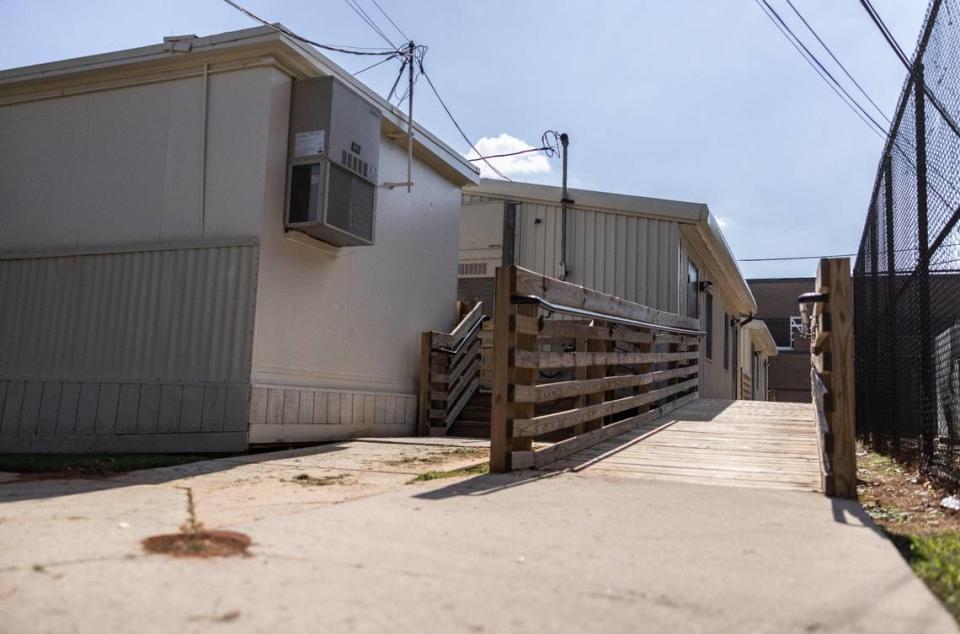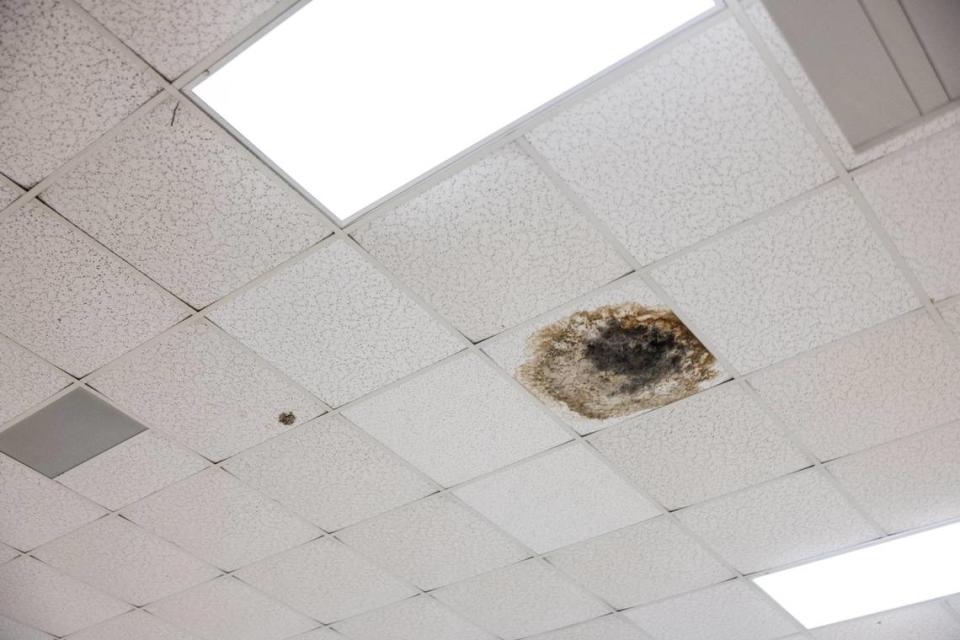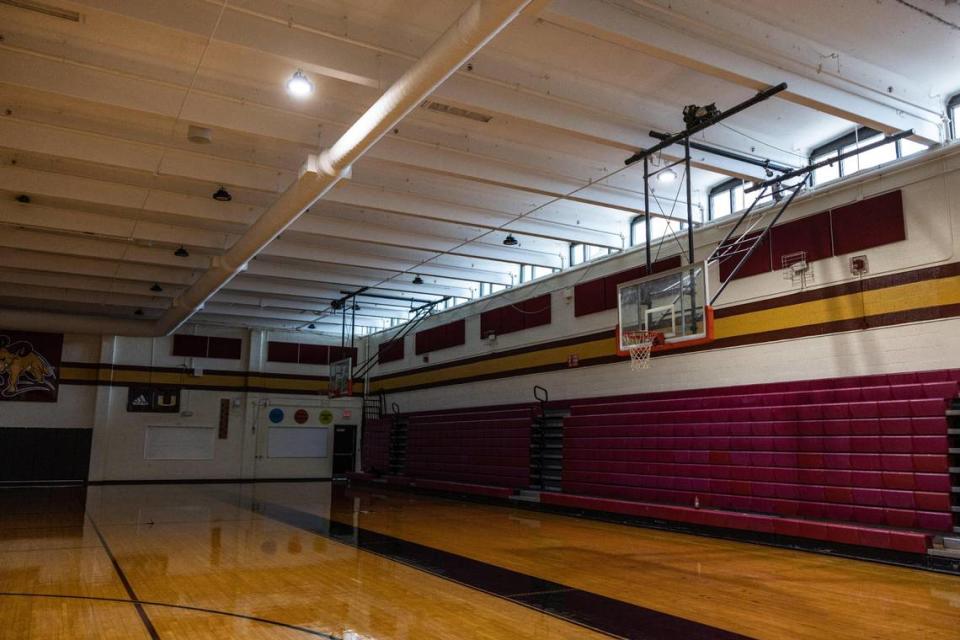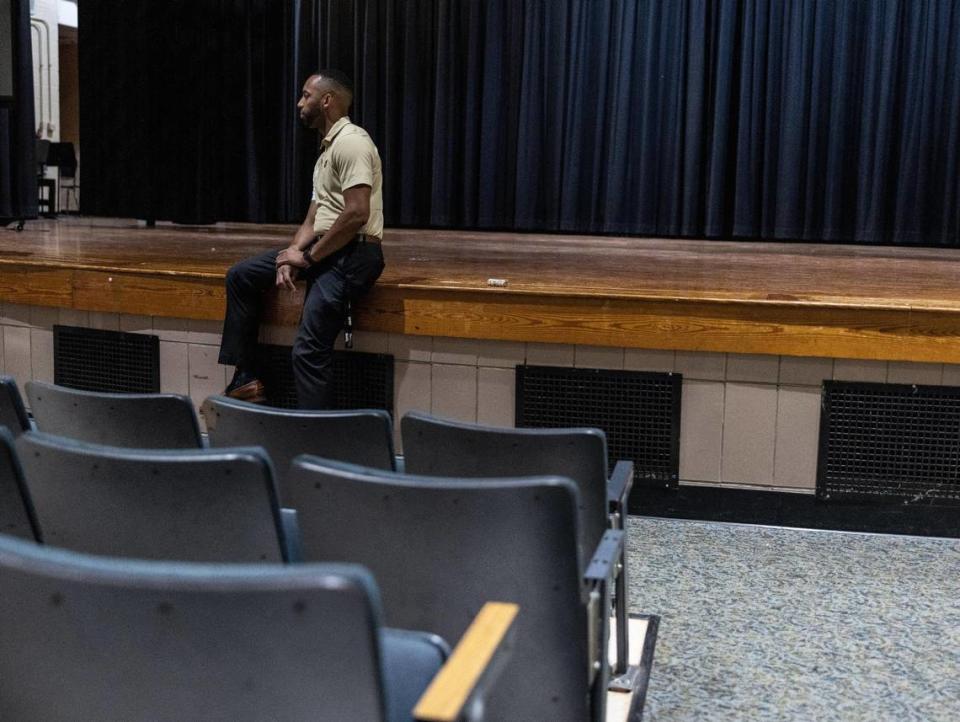How record $2.5 billion CMS bond tells Harding High students ‘they are worth it’
Jessica De Paz walked toward the magnificent white oak tree in the middle of Harding University High School’s campus.
The senior stopped underneath the centerpiece of the courtyard.
“This is one of the most important parts of our school,” she said. “We love it.”
Student pride is embedded here amid buildings rooted in history. But about a half-dozen of the buildings are falling apart on the campus that sits at 2001 Alleghany St. on Charlotte’s west side. About 1,300 students — predominantly Black and Hispanic — use old bathrooms with stalls that don’t close and classrooms with no windows. Buildings have shoddy air conditioning units and smell.
“Every building has smell problems,” said De Paz, who’s an athlete for the Rams and class president. “I can’t describe the smells. It’s just bad. There are amazing kids who come out of here. We enjoy our school. Just give it the appearance it deserves.”

Mecklenburg County residents on Nov. 7 will decide whether De Paz’s request is fulfilled. The ballot contains a $2.5 billion bond referendum for Charlotte-Mecklenburg Schools — a historic request for 30 projects district officials say will address some of the highest-need buildings. Harding University High, at a cost of about $203 million, is on the list of 30.
No voter in North Carolina has been asked to pass a bond of this size for a public school district. The last large bond referendum was in 2022 in Guilford County when voters passed $1.7 billion. Prior to that, the third-largest was CMS’ bond in 2017.
But Mecklenburg County commissioners followed County Manager Dena Diorio’s recommendation to include it in the budget and many county and city leaders, including Commissioner Chairman George Dunlap and Charlotte Mayor Vi Lyles, are urging residents to get behind the effort.
There are 30 projects. Some replace entire schools. Others add or replace buildings. And the largest portion of the 30 projects are are within the CMS Board of Education’s District 2, which is mostly contained within west Charlotte.
Dunlap calls it “a no-brainer.”
Conditions inside Harding University High

Glenn Starnes has worked in public schools along the East Coast since 2018. He was named Harding University High’s principal before the 2022-23 school year.
“This is the first time in my career that I’ve worked in a school building with such significant facility needs,” said Starnes of the school that opened in its current location 62 years ago. Prior to 1961, the former Harry P. Harding High School opened in 1935 on Irwin Avenue.
“There’s not enough brick-and-mortar space,” Starnes said. “We have 16 mobile classrooms. I can’t even fit an entire grade level in the auditorium.”
There are other concerns with the Harding University High campus — it consists of multiple unconnected buildings. Senior Jada Brown, a cheerleader, says she’s tripped on the sidewalk connecting the buildings because it’s cracked and uneven. And when it rains, corners of the courtyard flood.
“Everything is just an eyesore,” Brown said. “The ceilings and walls have stains. In some places near bathrooms you can smell what’s going on in those. We need a new building.”
Starnes says main issues include safety and security concerns about an open campus, the significant HVAC problems in all classrooms and outdated athletic facilities.
Residents from surrounding neighborhoods walk across Harding University’s campus during the day, which Starnes says is a shortcut to the Food Lion down the road from the school. When there are lockdowns, it’s difficult to “secure the perimeter,” he says.

“It would be so much safer if everyone was in one, connected physical location,” Starnes said. “Safety is the No. 1 concern.”
Besides that, the cafeteria has no windows, and despite four different lunch periods there’s barely enough space for all students. Wires also hang down throughout the kitchen area. Athletic facilities are aging — the track has only six lanes instead of eight. Shrubs and weeds are sprouting through the tennis courts. The gym, where physical education classes are held, has an old air-conditioner that barely cools. Hallways have dim lighting.
In the auditorium, some seats are lopsided and armrests are mismatched — Frankenstein-type solutions used throughout the years when an armrest broke.
“Band-Aids will only go so far until you have to actually replace them,” CMS board chair Elyse Dashew said. “If we don’t catch up and replace some of these buildings, we’re just going to get more behind and it’s going to get more expensive. I just know our kids deserve better. Our teachers deserve better.”
CMS facility needs

If voters approve the bond, Harding University High will get a new, three-story building that will connect to a few on campus that have already been rebuilt: a new gym and media center/administrative building known as the G building.
It will also get a comprehensive athletics package that includes new track and fields, synthetic turf football field, field houses and amenities.
And that’s just one school.
The project list includes other high schools, middle and elementary schools — most of which will receive new buildings. A new Second Ward Medical and Technology High School at the old metro site is also included.
Bond money will benefit communities throughout the county, Dashew said.
Mecklenburg, Guilford and Wake counties account for 28% of the statewide, five-year need for new construction, renovations, and additions to schools, according to a state Department of Public Instruction 2020-21 report.
CMS in 2022 estimated it needed more than $5.25 billion to complete 125 projects — from new schools to athletic facilities. The last CMS bond package voters approved in 2017 was just shy of $1 billion, CMS’ largest ever. New East Mecklenburg and West Charlotte high schools are examples of completed construction from that referendum.
“Without question, the students and teachers at Harding University High School are ready for a new building,” Starnes said. “So often I hear, ‘Mr. Starnes, why don’t we have what xyz school has’, and I typically say, ‘we will one day.’”
Burden on taxpayers?
Opponents of the bond, including the African American Faith Alliance and multiple candidates running for three at-large seats on the school board, cite concerns it places too much burden on taxpayers and projects aren’t fairly distributed. The alliance claims CMS is failing Black students.
Superintendent Crystal Hill during a presentation to the Hood Hargett Breakfast Club in September said the bond, if approved, would likely require property tax increases in 2025, 2028 and 2029. Those increases of 1 cent per $100 in valuation each will help pay for debt associated with the package.
A project site list by Mecklenburg Board of County Commissioners districts shows the 30 projects are distributed across all six districts. A third of the projects are for schools in District 2, which includes the west side of Charlotte,
Another school on Charlotte’s west side benefited from the 2017 bond — one that 73% of voters supported. That bond did not increase taxes, according to officials in Mecklenburg County’s department of financial services. But it helped West Charlotte High kick off the 2022-23 school year in a new three-story, 100-classroom building on the property at 2219 Senior Drive, where it has been since 1954. The school originally opened in 1938 on 1415 Beatties Ford Road.
West Charlotte High Principal Orlando Robinson told the Observer the old campus possessed so much history and legacy. The new building, though, exudes excellence.
“Our scholars entered the new building with pride and disbelief. They could not believe how nice the new building was,” Robinson said. “They walked up and down the stairs looking around and transitioned from floor to floor, admiring the decor and colors splashed all throughout the building. The one thing I kept hearing was that we are all in one building, the previous campus had 19 buildings. Being in one building has helped us become more connected.”
Do new buildings change outcomes?
Researchers from the California Policy Lab at UCLA and UC Berkeley concluded in a report that a more than $10 billion, multiyear school construction effort in the Los Angeles Unified School District during the early 2000s had a positive academic impact on students, according to a report published in 2019 in Education Week. They found that four years after having moved to a newly constructed school, students showed “modest improvement” in English/language arts and math test scores.
Daily attendance also improved, according to the report.
“From the new walls, to the big beautiful glass windows, to the fresh flooring and bright lights, our building communicates to students through the walls and state of the art features that they matter,” Robinson said, “that they deserve a beautiful learning environment, and that they are worth it.”
West Charlotte High, according to student performance data for the 2022-23 school year the state released in September, received a D letter grade but exceeded growth expectations. For the first time since before the 2018-19 school year, the state removed the “low-performing” status from West Charlotte High.
“We have absolutely noticed a difference with students,” Robinson said. “They’re proud of our school building, they feel safe in our school, and I believe that it has increased the level of engagement and investment that scholars have in their school because of the presence of a newer and nicer building that represents the excellence that our scholars have within themselves.”
It’s what De Paz says she wants for the students who come after her at Harding University High, where, by the way, if the bond passes and it gets rebuilt, that white oak nicknamed “The Tree” will stay.

